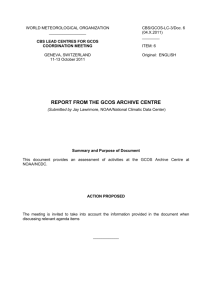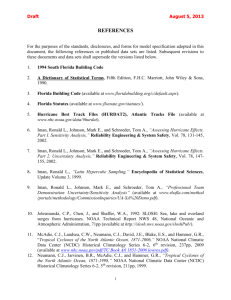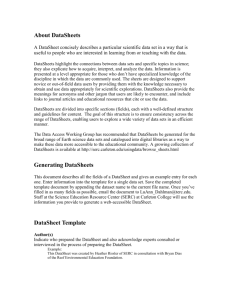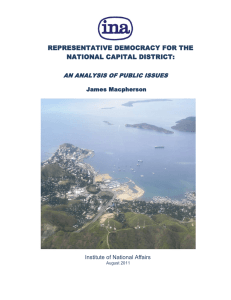The NOAA National Climatic Data Center: Data Availability
advertisement
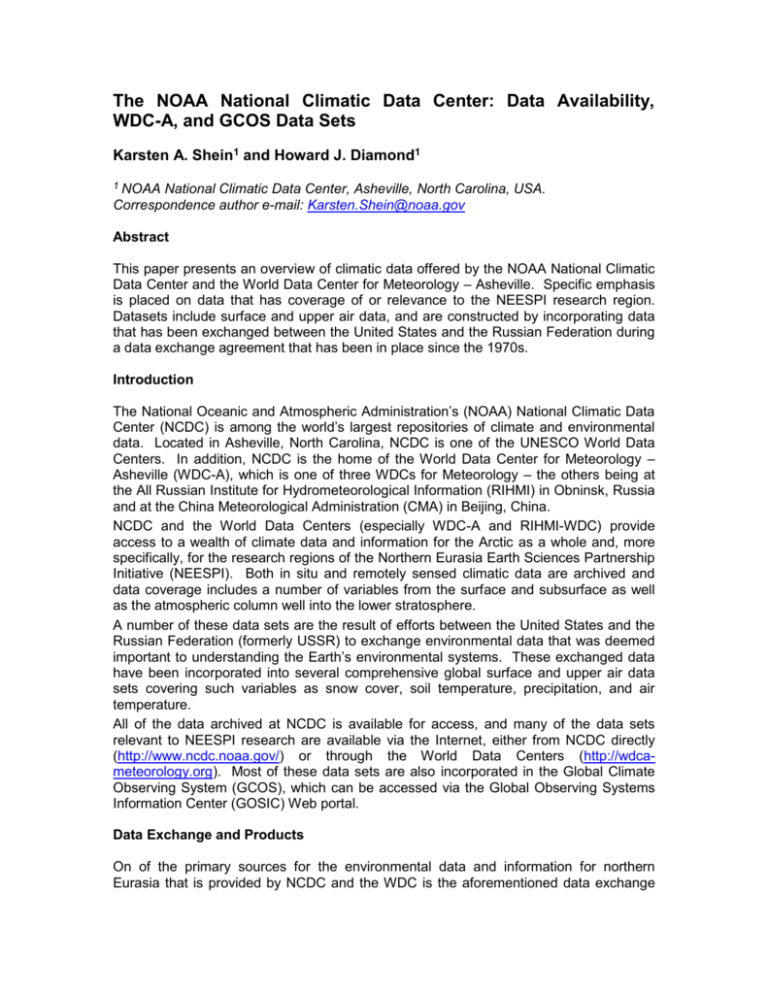
The NOAA National Climatic Data Center: Data Availability, WDC-A, and GCOS Data Sets Karsten A. Shein1 and Howard J. Diamond1 1 NOAA National Climatic Data Center, Asheville, North Carolina, USA. Correspondence author e-mail: Karsten.Shein@noaa.gov Abstract This paper presents an overview of climatic data offered by the NOAA National Climatic Data Center and the World Data Center for Meteorology – Asheville. Specific emphasis is placed on data that has coverage of or relevance to the NEESPI research region. Datasets include surface and upper air data, and are constructed by incorporating data that has been exchanged between the United States and the Russian Federation during a data exchange agreement that has been in place since the 1970s. Introduction The National Oceanic and Atmospheric Administration’s (NOAA) National Climatic Data Center (NCDC) is among the world’s largest repositories of climate and environmental data. Located in Asheville, North Carolina, NCDC is one of the UNESCO World Data Centers. In addition, NCDC is the home of the World Data Center for Meteorology – Asheville (WDC-A), which is one of three WDCs for Meteorology – the others being at the All Russian Institute for Hydrometeorological Information (RIHMI) in Obninsk, Russia and at the China Meteorological Administration (CMA) in Beijing, China. NCDC and the World Data Centers (especially WDC-A and RIHMI-WDC) provide access to a wealth of climate data and information for the Arctic as a whole and, more specifically, for the research regions of the Northern Eurasia Earth Sciences Partnership Initiative (NEESPI). Both in situ and remotely sensed climatic data are archived and data coverage includes a number of variables from the surface and subsurface as well as the atmospheric column well into the lower stratosphere. A number of these data sets are the result of efforts between the United States and the Russian Federation (formerly USSR) to exchange environmental data that was deemed important to understanding the Earth’s environmental systems. These exchanged data have been incorporated into several comprehensive global surface and upper air data sets covering such variables as snow cover, soil temperature, precipitation, and air temperature. All of the data archived at NCDC is available for access, and many of the data sets relevant to NEESPI research are available via the Internet, either from NCDC directly (http://www.ncdc.noaa.gov/) or through the World Data Centers (http://wdcameteorology.org). Most of these data sets are also incorporated in the Global Climate Observing System (GCOS), which can be accessed via the Global Observing Systems Information Center (GOSIC) Web portal. Data Exchange and Products On of the primary sources for the environmental data and information for northern Eurasia that is provided by NCDC and the WDC is the aforementioned data exchange activity between NOAA and Roshydromet (Russia). This exchange was begun in the 1970s as a means to gain a more complete global understanding of the environment. Since that time, the exchange activities have included not only the transfer of valuable environmental data, but have fostered a number of collaborative international research projects, especially in the Arctic. Research activities and data exchanges have taken place at many institutions in both Russia and the United States, including several universities (e.g., St. Petersburg State University, University of Alaska, and University of Maryland) in addition to a number of governmental institutions in both countries (e.g., Russian Academy of Science, Main Geophysical Observatory, University Consortium for Atmospheric Research). Exchanges of data for the Arctic and northern Eurasia have included oceanographic data collected by US and Russian research vessels (e.g., water temperature, ice thickness, salinity), terrestrial data such as soil temperatures, state of the ground (i.e., frozen, unfrozen), and snow cover extent, and atmospheric data that include meteorological measurements for several thousand surface stations (many in the NEESPI region) and hundreds of upper-air radiosonde balloons, and extensive satellite coverage. Surface (land and sea) atmospheric measurements that are available for locations within the NEESPI research domain include air temperature, precipitation, solar radiation, wind speed and direction, air pressure, and trace gasses such as Carbon Dioxide and Ozone. Most of these data are available at either daily or monthly time scales, while a few (e.g., air temperature) are available at synoptic (hourly or 3-hourly) scales, and most of these data sets receive regular and timely updates via the Global Telecommunications System (GTS) or via FTP from their respective originating organizations. In this way, data users are ensured of having the most up-to-date data through the present. Although the exchanges have been ongoing, new datasets continue to become available. For example, as part of a data rescue effort by Roshydromet, a data set of monthly mean air temperatures from the Russian Empire between 1743 and 1928 is now available as NCDC Dataset DSI-9809. Data Access In the United States, all exchanged atmospheric data is archived at NCDC and the WDC-A, with the exception of some trace gas data that is housed at the Carbon Dioxide Information and Analysis Center (CDIAC) in Oak Ridge, Tennessee (http://cdiac.ornl.gov). In Russia, these data are available from RIHMI-WDC (http://meteo.ru/english/). These data are primarily available as part of larger, globalcoverage datasets such as the Global Historical Climate Network (GHCN) for daily and monthly surface data, and the Integrated Global Radiosonde Archive (IGRA) for daily upper air data. In addition, there are numerous data sets that are available from the WDC through at least 28 major international research projects (e.g., International Polar Year) and programs (e.g., Global Climate Observing System). These and other data are nearly all on-line and can usually be accessed via NCDC’s Web interface (see Figure 1) or through the World Data Centers. In addition, and for data that is not available via the Internet, fax, telephone and postal mail orders also are accepted and processed. To better identify and link to data that may not be held at NCDC, Web portals, such as GOSIC (http://www.gosic.org/ - see Figure 2) or the Global Change Master Directory (GCMD – http://gcmd.nasa.gov) may be helpful. These portals provide access to a searchable metadata directory that directs the seeker to relevant data sets and provides information regarding data access and restrictions. While current Web-based methods provide the most expedient access to these data, there are ways in which access can be improved. Currently, NCDC offers some spatial and temporal search capabilities via its Web map server and Climate Data Online (CDO). However, the ability to efficiently subset data products has been a shortcoming in the current system (most data reside in flat files that must be completely downloaded and then parsed by the user). Search interfaces that can be tied to relational databases present some promise in giving the data requestor the ability to request specific subsets of data. Such technology may also more easily facilitate the searching of multiple data sets with disparate data (and from diverse sources), and the retrieval of an integrated data product tailored to the individual user’s requirements (i.e., variables, formats, spatial and temporal extent). At the present time, NCDC and the WDC are evaluating methods that might make such search and retrieval a possibility. Figure Legends Figure 1. Home page of NOAA’s National Climatic Data Center. Figure 2. Home page of the Global Observing Systems Information Center (GOSIC). Figure 1. Home page of NOAA’s National Climatic Data Center Figure 2. Home page of the Global Observing Systems Information Center (GOSIC)
